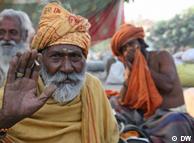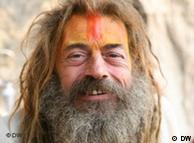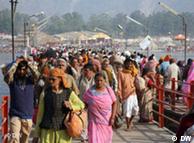 |
| 大甲媽祖起駕日鎮瀾宮擠滿信徒。 (記者張軒哲攝) |
〔記者張軒哲/大甲報導〕大甲媽祖遶境16日出發,信眾午後陸續湧入大甲市區,交通一團亂,鎮瀾宮前舞台從早到晚活動不斷,各地陣頭爭相參拜獻藝,國內外傑出演藝團隊帶來精采活動,分享媽祖遶境。
由於信眾午後陸續湧入大甲市區,導致市區交通壅塞,即使午後3時實施交通管制,外圍中山路與甲后路依舊車陣綿延,駕駛怨聲四起。鎮瀾宮也擠入大批香客,寸步難行,但為了參拜媽祖,眾人只好耐著性子,遵守各項規定。
大 甲媽祖遶境起駕日為能使中外人士欣賞表演節目,觀看盛大的進香隊伍及精采的陣頭表演,縣府在經國路及中山路口設置「國際觀禮台」。昨日有「絕品爵士樂 團」、大甲五十三庄傳統武術、少林武術表演,國外表演團隊有西非烏轆轆特技團、白俄羅斯明星馬戲團、胡志明市東方傳奇馬戲團及烏蘭巴托紅色英雄馬戲團。
起駕前各陣頭都親臨鎮瀾宮前向媽祖祈請起駕,這些隊伍中以電音三太子團最吸引眾人目光,來自彰化的南瑤宮的電音團婦女,大跳流行的SORRY、SORRY舞,讓現場香客驚艷。
今 年大專生參與活動演出人數為歷年之最,有台中教育大學、亞洲大學及朝陽科技大學熱舞社近百名學子熱情演出。長相英挺的日本電影「黑帶」男主角八木明人,為 鍊士六段的沖繩傳統空手道古武道比賽冠軍,首次來台觀看媽祖出城盛況,昨日與台灣忠義館總館掌門呂松吉沿大甲街頭演出獻藝,台灣派出三大武林高手禮數相 迎。
Religion | 16.04.2010
India's naked holy men gather in Haridwar
Flicking away his dreadlocks, Guru Dattatare Vijayate lights up his chillum, a marijuana pipe, and blows a conch shell. He is a Naga Sadhu or Baba, one of India’s naked ash-smeared holy men who only appear in public during the Kumbh Mela.
Usually, these followers of Lord Shiva live in caves in the remote Himalayas. They have matted hair, smoke marijuana and lead a life of austerity, which includes religious worship, meditation and yoga.
 Bildunterschrift: Naga Sadhus at their camp in Haridwar
Bildunterschrift: Naga Sadhus at their camp in Haridwar
Guru Dattatare Vijavate says the drug helps him concentrate better. He is a member of the Juna Akhara, the largest of 13 sects, and has travelled a great distance to take part in the festivities in Haridwar.
One of the reasons for the festival is also to induct aspirants, he explains. "It takes 12 years to become a Naga Sadhu, for which you have to perform severe penance. Currently, we have 130,000 saints in our fold. We are Dattatare saints and we travel. We smoke marijuana so it can mystically transform into psychic and spiritual power and we live in the Himalayas in the summer. We need money for our marijuana as we need to meditate."
No compromise on beliefs or rites
Naga Sadhus have never compromised on their spiritual beliefs and rites, which have not changed over the centuries. They practice three types of yoga, which help them survive low temperatures. The cornerstone in their lives is restraint - both in food and thought.
 Bildunterschrift: Pilgrims prepare for the most important day of the Kumbh Mela, Baisakhi
Bildunterschrift: Pilgrims prepare for the most important day of the Kumbh Mela, Baisakhi
The Naga Babas are also a warrior class, divided like an army regiment. The trident, sword, conch shells and the chillum are what they carry to symbolize their warrior status.
Tim Baba originally hails from England and is also a member of the Juna Akhada sect. "I first came here 18 years ago and found Bhagwan. I found out that Bhagwan is one. One world, one people, one god. All religions lead to God. God is the truth. Kumbh is Kumbh, many people coming forever for God. Good energy everywhere, bad energy everywhere. This is the world."
 Bildunterschrift: Großansicht des Bildes mit der Bildunterschrift: Tim Baba, a Naga Sadhu originally from England
Bildunterschrift: Großansicht des Bildes mit der Bildunterschrift: Tim Baba, a Naga Sadhu originally from England
A life of isolation from an early age
Most Naga Sadhus leave their families at an early age. They give up creature comforts and sever all ties. They prefer to stay away from the scrutiny and glare of the media as well as from tourists and devotees. Their reputation of being volatile and unpredictable helps keep people away.
During the indoctrination process, they only wear a loin cloth and after taking the pledge of sanyaas, or renunciation, at the Kumbh Mela, they give up clothes for the rest of their lives.
"Ever since I was a child I have been undergoing sacrifices to become a Naga Sadhu,” says Naga Nirmal Babu, who is 30, and has been a member of the sect for five years. "Only through service to my guru have I managed to become what I am now. Through his blessings, I have managed to reach this stage. My soul is clean and that is important."
The lives of India's holy men vary. Some live in religious hermitages and temples in the midst of major urban centers, in huts on the edges of villages, or in caves in the remote mountains. Although history has already produced many changes in India, the life of Naga Sadhus is likely to remain the same.
Author: Murali Krishnan (Haridwar)
Editor: Anne Thomas

沒有留言:
張貼留言